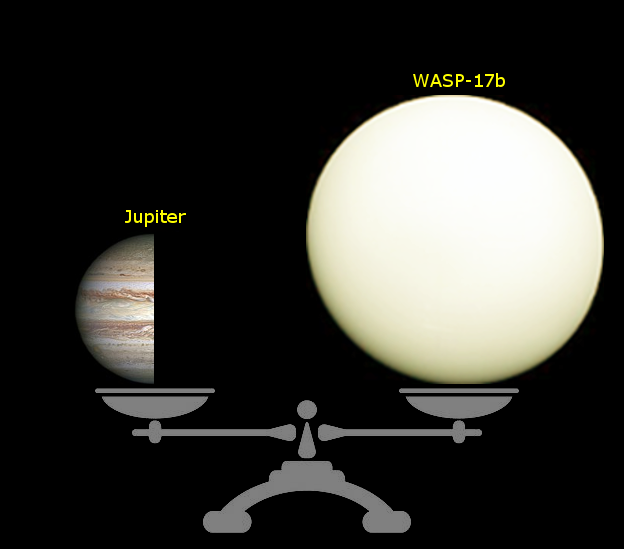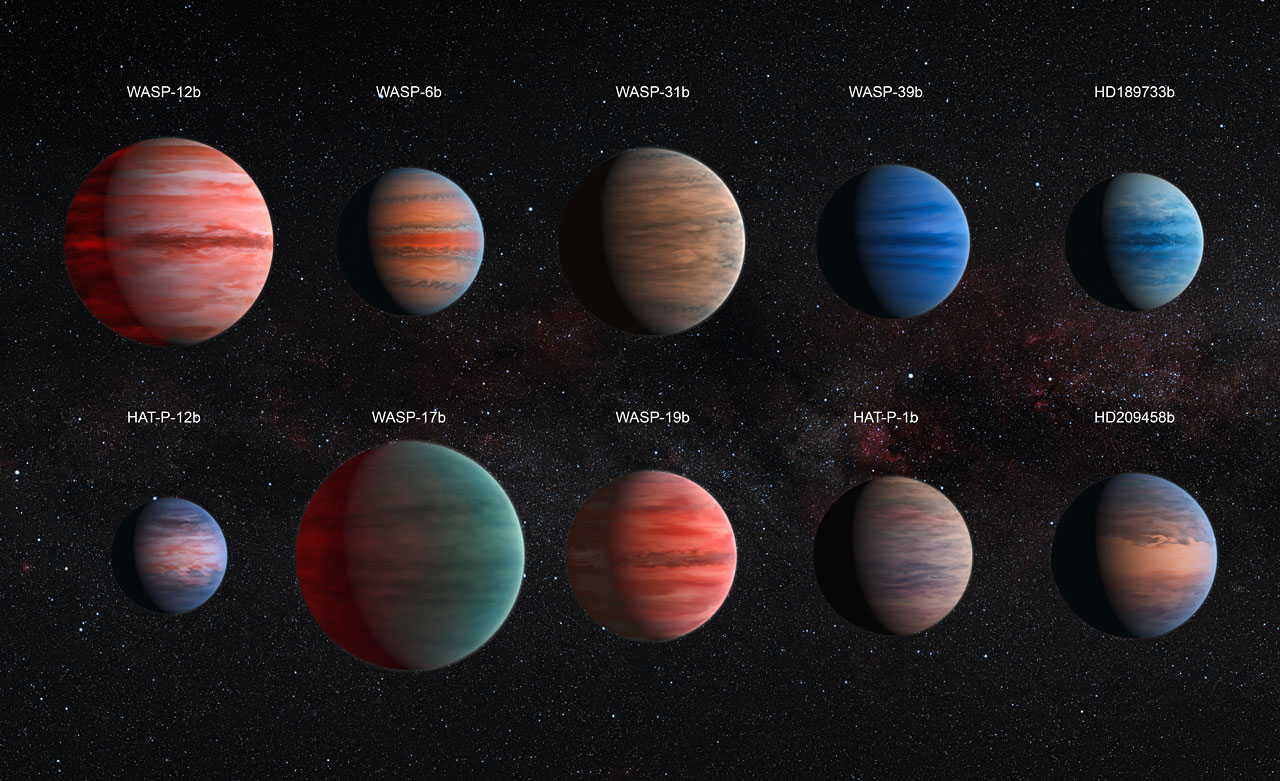WASP-17 b: Absolutely Inflated Supercharged Gas Giant
In a universe filled with wonder and mystery, WASP-17 b stands out as a captivating celestial oddity. This remarkable exoplanet, located approximately 1,000 light-years away in the constellation Scorpius, defies expectations with its extraordinary characteristics. Measuring roughly twice the size of Jupiter, this giant gas planet challenges conventional notions of planetary structure and behavior.
Unlike most planets, WASP-17 b has a highly elongated, egg-shaped orbit. Its strange path takes it so close to its star that its atmosphere is being stretched and distorted, creating a mind-boggling phenomenon. Scientists have dubbed this celestial marvel as an “inflated hot Jupiter.”
Through cutting-edge research and advanced telescopic observations, astronomers are unraveling the mysteries surrounding this remarkable celestial body. Their findings provide valuable insights into the complex nature of planetary formation, dynamics, and interactions in the vastness of our universe.
Get ready to embark on a fascinating journey into the realm of exoplanets as we delve deeper into the extraordinary world of latoto WASP-17 b. Brace yourself for a captivating exploration that challenges our understanding of the cosmos and leaves us in awe of the wonders that lie beyond our Earthly realm.
Discovering WASP-17 b
The discovery of WASP-17 b was made possible through the efforts of the Wide Angle Search for Planets (WASP) project, which aims to detect exoplanets using the transit method. This technique involves observing the slight dimming of a star’s light as a planet passes in front of it. In 2009, astronomers detected this unique planet, quickly noting its unusual characteristics compared to other known exoplanets.
One of the most striking aspects of WASP-17 b is its size. At approximately 1.5 times the diameter of Jupiter, it ranks among the largest known exoplanets. However, its mass is surprisingly low for such dimensions, leading to the classification of WASP-17 b as an “inflated” hot Jupiter. This classification has spurred significant interest in understanding how such a massive yet lightweight planet could exist in the universe.
The discovery of WASP-17 b not only broadened our understanding of the diversity of exoplanets but also raised new questions about planetary formation and evolution. Since its discovery, astronomers have conducted extensive studies to investigate the planet’s unusual properties and how they relate to its host star and surrounding environment. Each observation brings us closer to unraveling the mysteries of this enigmatic planet.

Unique Characteristics of WASP-17 b
WASP-17 b is not just another giant gas planet; it possesses a set of unique characteristics that set it apart from its counterparts. One of the most notable features is its inflated size, which has sparked debates about its formation and evolutionary history. Typically, gas giants like Jupiter are denser and smaller, but WASP-17 b’s low density indicates that it has a significant amount of heat in its atmosphere, causing it to expand.
Another fascinating aspect of WASP-17 b is its orbital eccentricity. The planet follows a highly elongated, egg-shaped path around its host star, resulting in significant temperature variations as it moves closer and farther away. The extreme proximity to its star leads to scorching surface temperatures, sometimes exceeding 1,800 degrees Fahrenheit (1,000 degrees Celsius). This intense heat contributes to the planet’s atmospheric dynamics, which are unlike those of any other known exoplanet.
Moreover, WASP-17 b’s atmospheric composition is a subject of intense study. Astronomers have detected various compounds in its atmosphere, including water vapor, sodium, and potassium. The presence of these elements suggests complex chemical reactions occurring under extreme conditions. Understanding these atmospheric processes not only sheds light on WASP-17 b itself but also provides valuable insights into atmospheric science across other exoplanets.
The Inflated Nature of WASP-17 b
The term “inflated” when referring to WASP-17 b highlights its unique physical characteristics. Unlike traditional gas giants, which maintain a balance between gravitational forces and internal pressure, WASP-17 b appears to have an excess of heat that causes it to expand. This inflation raises questions about the mechanisms behind its formation and the physical processes that sustain its current state.
One of the primary hypotheses explaining the inflated nature of WASP-17 b is the concept of “internal heating.” This phenomenon occurs when a planet experiences tidal forces due to its close proximity to its host star. As the planet orbits, the gravitational pull causes its shape to stretch and distort, leading to the release of energy in the form of heat. This energy contributes to the inflation of the planet, preventing it from cooling and contracting like other gas giants.
Another aspect of WASP-17 b’s inflation involves the interaction between its atmosphere and the stellar radiation it receives. The intense heat from the host star causes the atmosphere to expand, creating a more diffuse layer of gases. This situation can also lead to atmospheric escape, where lighter elements are stripped away over time, further influencing the planet’s overall structure and composition.
Theories and Explanations for Its Inflation
Understanding the mechanisms behind the inflation of WASP-17 b requires a multidisciplinary approach, integrating theories from astrophysics, planetary science, and atmospheric dynamics. One of the leading theories revolves around the role of stellar radiation in shaping the planet’s atmosphere. The intense heat from the host star can lead to the dissociation of molecules in the atmosphere, resulting in a less dense and more expansive structure.
Additionally, researchers are investigating the impact of the planet’s orbital dynamics on its inflation. WASP-17 b’s elongated orbit causes it to experience significant variations in temperature as it moves through its path. This fluctuation can create a cycle of heating and cooling that influences the atmospheric pressure and density, contributing to its inflated appearance.
Furthermore, the composition of WASP-17 b’s atmosphere plays a crucial role in its inflation. The presence of specific elements and compounds can affect how efficiently the planet retains heat. For instance, water vapor and other greenhouse gases can trap heat, leading to a further increase in temperature and inflation. Understanding these interactions provides a clearer picture of how WASP-17 b maintains its unusual state.

The Importance of Studying WASP-17 b
Studying WASP-17 b is not only crucial for understanding this particular exoplanet but also offers broader insights into the nature of planetary systems. The unique characteristics of WASP-17 b challenge conventional models of planetary formation and evolution, prompting scientists to rethink how gas giants develop in different environments.
Moreover, WASP-17 b serves as a laboratory for testing theories of atmospheric dynamics under extreme conditions. The extreme temperatures and unusual atmospheric compositions present a unique opportunity to study processes that may also occur on other exoplanets. By understanding the mechanisms that govern WASP-17 b’s atmosphere, we can apply this knowledge to a broader range of celestial bodies, enhancing our understanding of planetary atmospheres in general.
Additionally, the study of WASP-17 b can provide valuable insights into the potential for habitability in other systems. By examining how planets interact with their stars and how their atmospheres respond to various conditions, scientists can develop more accurate models for assessing the habitability of exoplanets in different environments. This understanding is essential as we continue to explore the cosmos in search of life beyond our own planet.
Current Research and Observations
Researchers are actively engaged in studying WASP-17 b using various advanced observational techniques and space-based telescopes. The Hubble Space Telescope has played a pivotal role in characterizing the planet’s atmosphere, allowing astronomers to detect the presence of specific elements and compounds. These observations have revealed a wealth of information about the chemical makeup and dynamics of WASP-17 b’s atmosphere.
In addition to Hubble, the Transiting Exoplanet Survey Satellite (TESS) has contributed to the ongoing research by providing detailed data on the planet’s transit events. TESS’s observations allow scientists to monitor changes in brightness and further refine our understanding of the planet’s orbital dynamics. This collaborative effort among multiple observatories enhances our ability to study WASP-17 b from various angles, uncovering new insights about its behavior and characteristics.
Current research also focuses on modeling the atmospheric dynamics of WASP-17 b. By simulating the interactions between the planet’s atmosphere and its host star, scientists can gain insights into how temperature variations influence weather patterns and atmospheric circulation. These models help predict future observations and refine our understanding of the underlying mechanisms driving the planet’s inflation and atmospheric behavior.
The Future of Studying WASP-17 b
As technology continues to advance, the future of studying WASP-17 b holds great promise. Upcoming space missions, such as the James Webb Space Telescope (JWST), are expected to provide unprecedented views of exoplanets and their atmospheres. With its advanced capabilities, JWST will enable astronomers to conduct in-depth analyses of WASP-17 b, revealing new details about its composition, structure, and dynamics.
In addition to space telescopes, ground-based observatories equipped with new instruments will also play a vital role in future research. These observatories can conduct follow-up observations and monitor changes in the planet’s atmosphere over time. By combining data from multiple sources, researchers can create a comprehensive picture of WASP-17 b’s behavior and how it evolves in response to its environment.
Moreover, researchers plan to explore the potential for studying similar exoplanets to compare their characteristics with those of WASP-17 b. By identifying other inflated hot Jupiters and analyzing their atmospheres and orbits, scientists can develop a more complete understanding of the processes that govern the evolution of gas giants in diverse environments. This comparative approach will enhance our knowledge of planetary systems and their formation across the universe.

Similar Exoplanets to WASP-17 b
WASP-17 b is not alone in the realm of inflated gas giants; several other exoplanets exhibit similar characteristics, offering intriguing comparisons. One notable example is WASP-12 b, another inflated hot Jupiter located approximately 1,500 light-years away. Like WASP-17 b, WASP-12 b orbits its star at an incredibly close distance, leading to extreme heating and an elongated shape.
Another interesting counterpart is HAT-P-32 b, which shares some features with WASP-17 b, including its inflated size and close proximity to its host star. The study of these similar exoplanets helps scientists understand the commonalities and differences in their formation processes, atmospheric dynamics, and interactions with their stars.
By examining multiple inflated hot Jupiters, researchers can begin to identify patterns and trends that may apply across various planetary systems. This knowledge not only helps in understanding WASP-17 b but also contributes to the broader field of exoplanetary science, paving the way for future discoveries and insights.
Conclusion and Final Thoughts
In conclusion, WASP-17 b stands as a remarkable testament to the diversity and complexity of planetary systems in our universe. Its inflated nature, unique characteristics, and unusual orbital dynamics challenge our existing models of planetary formation and evolution. As astronomers continue to study this captivating exoplanet, they unravel the mysteries of its atmosphere, structure, and behavior, shedding light on the intricate processes that govern celestial bodies. If you like reading this article then please visit bluecheddar to read more article like this.
